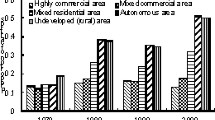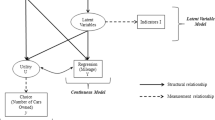Abstract
Due to its manifold impact on the environment private car use represents an important dimension of environmental behavior in industrialized countries. Obviously, private car use is related to demographic characteristics of households such as the life-cycle stage and the living arrangement the household lives in. In addition systematic regional differences of private car use have to be taken into account. In this paper a causal model is derived, which aims to explain regional differences in car ownership and car use by regional demographic differences and region-specific control factors such as the car technology and institutional factors. Using aggregate data from a household survey in Austria and data from Austrian official statistics causal effect coefficients are then estimated. By applying path analysis the estimated effects of regional demographic characteristics on region-specific car ownership and car use can be decomposed into direct and indirect effects, with the latter effects being mediated by the control factors. Except for the average age of household heads and population density no significant direct demographic effects on regional patterns of car ownership and car use can be found. Car ownership and car use are best predicted by using the considered control factors as predictor variables. Nevertheless, many of the presumed indirect effects turn out to be of importance since demographic factors are closely linked to measures of regional institutional settings like per capita income, ownership of house/apartment and net commuting index.
Similar content being viewed by others
References
Adlmannseder, J. (1993). Raum-und Zeitverhalten von Ozon in den westlichen Stadtbezirken von Graz. Mitteilungen des naturwissenschaftlichen Vereins der Steiermark 123, 19-31.
Bailey, K.D. (1990). From POET to PISTOL: Reflections on the Ecological Complex. Sociological Inquiry 60, 387-394.
Bamberg, S. & Schmidt, P. (1998). Eisozialpsychologischer Ansatz zur Erkäl rung der individuellen Verkehrsmittelwahl und der Evaluation der Wirksamkeit verkehrspolitischer Maßnahmen. In Schupp, J. & Wagner, G. (Eds.). Umwelt und empirische Sozialforschung. Beiträge der Projektgruppe “Das Sozio-oekonomische Panel” am Deutschen Institut für Wirtschaftsforschung (DIW Sonderheft 165) (pp. 121-149). Berlin: Duncker und Humblot.
Black, J.S., Stern, P.C., & Elworth, J.T. (1985). Personal and contextual influences on household energy adaptations. Journal of Applied Psychology 70(1), 3-21.
Brüderl, J. & Preisendörfer, P. (1995). Der Weg zum Arbeitsplatz: Eine empirische Untersuchung der Verkehrsmittelwahl. In Diekmann, A. & Franzen, A. (Eds.). Kooperatives Umwelthandeln. Modelle, Erfahrungen, Massnahmen (pp. 69-88). Chur/Zurich: Rüegger.
Canzler, W. & Knie, A. (1994). Das Ende des Automobils. Fakten und Trends zum Umbau der Automobilgesellschaft. Heidelberg: Müller.
Carlsson-Kanyama, A. & Linden, A.L. (1999). Travel patterns and environmental effects now and in the future: implications of differences in energy consumption among socio-economic groups. Ecological Economics 30, 405-417.
Catton, W.R. (1987). The World's Most Polymorphic Species: Carrying Capacity Transgressed Two Ways. BioScience 37, 413-419.
Cramer, J.C. (1998). Population Growth and Air Quality in California. Demography 35, 45-56.
Cramer J.C. & Cheney, R.P. (2000). Lost in the Ozone: Population growth and Ozone in California. Population & Environment 21, 315-337.
Diekmann, A. & Preisendo¨rfer, P. (1992). Persö nliches Umweltverhalten. Diskrepanzenzwischen Anspruch und Wirklichkeit. Kölner Zeitschrift für Soziologie und Sozialpsychologie 44, 226-251.
Ehrlich, P. & Holdren, J. (1971). Impact of Population Growth. Science 171, 1212-1217.
Engel, U. & Pötschke, M. (1998). Willigness to pay for the environment: social structure, value orientation and environmental behavior in a multilevel perspective. Innovation 11(3), 315-332.
Greene, W.H. (1993). Econometric Analysis. New York: Macmillan Publishers.
Heigl, A. & Mai, R. (1998). Demographische Alterung in den Regionen der EU. Zeitschrift für Bevölkerungswissenschaft 23, 293-317.
Hunecke M. (1998). Őkologische Verantwortung und Lebensstile als Prädiktoren für Umweltverhalten. In Schupp J.& Wagner G.Eds.Umwelt und empirische Sozialforschung. Beiträge der Projektgruppe “Das Sozio-oekomische Panel” am Deutschen Institut für Wirtschaftsforschung (DIW Sonderheft 165) (pp.101-120). Berlin: Duncker und Humblot.
Jagodzinski, W. (1986). Pfadmodelle mit latenten Variablen: Eine Einführung in das allgemeine lineare Modell LISREL. In Hummell, H.J., Jagodzinski, W. & Langeheine, R. (Eds.). Kausalanalyse (Techniken der empirischen Sozialforschung 8) (pp. 77-121). Munich: Oldenbourg.
Jahn, T. & Schultz, I. (1995). Stadt, Mobilität und Lebensstile—ein sozial-ökologischer Forschungsansatz. In Sahner, H. & Schwendter, S. (Eds.). Gesellschaften im Umbruch. Vol. II (pp. 795-800). Opladen: Westdeutscher Verlag.
Kautz, H., Krajasits, C., & Eisenkölb, G. (1999). Regionalbericht 1998. Vienna: Ősterreichisches Institut für Raumplanung.
Krause, C. (1997). Auto-Typen. PKW-Zielgruppenforschung mit den SINUS-Milieus. Media Spectrum 11/97, 32-33.
List, J.A. & Gallet, C.A. (1999). The Environmental Kuznets Curve: Does One Size Fit All?. Ecological Economics 31, 409-423.
Lorbeer, D.A. (1996). Auto und Umwelt. Gegenwartskunde. Zeitschrift für Gesellschaft, Wirtschaft, Politik und Bildung 45/1, 101-111.
Lutzenhiser, L. & Hackett, B. (1993). Social Stratification and Environmental Degradation: Understanding Household CO2 Production. Social Problems 40, 50-73.
MacKellar, F.L., Lutz, W., Prinz, C., & Goujon, A. (1995). Population, Households, and CO2 Emissions. Population and Development Review 21, 849-865.
Mikl-Horke, G. & Leuker, H. (1978). Das Auto als Verhaltensdeterminante (Berichte des Institutes für Allgemeine Soziologie und Wirtschaftssoziologie an der Wirtschaftsuniversität Wien 17). 2nd edition. Vienna: Ősterreichisches Gesellschaft für Wirtschaftssoziologie.
Newman, P.W.G. & Kenworthy, J.R. (1988). The Transport Energy Trade-off: Fuel-efficient Traffic versus Fuel-efficient Cities. Transport Research A 22A, 163-174.
Ősterreichisches Statistisches Zentralamt (Ed.) (1996). Karte der NUTS-Gliederung Ősterreichs der Ebenen 1 bis 3. Vienna: Ősterreichisches Statistisches Zentralamt.
Ősterreichisches Statistisches Zentralamt (Ed.) (1997). Statistisches Jahrbuch für die Republik Ősterreich, XLVIII. Jahrgang, N.F., 1997. Vienna: üsterreichisches Statistisches Zentralamt.
Ősterreichisches Statistisches Zentralamt (Ed.) (1998). Energieverbrauch der Haushalte 1996/97. Ergebnisse des Mikrozensus Juni 1997. Bearbeitet im Ősterreichischen Statistischen Zentralamt (Beitra¨ge zur o¨sterreichischen Statistik 1279). Vienna: Ősterreichisches Statistisches Zentralamt.
Polster, W. & Voy, K. (1991). Eigenheim und Automobil—Materielle Fundamente der Lebensweise. In Voy, K., Polster, W., & Thomasberger, C. (Eds.). Gesellschaftliche Transformationsprozesse und materielle Lebensweise (Beiträge zur Wirtschafts-und Gesellschaftsgeschichte der Bundesrepublik Deutschland (1949-1989). Vol. 2 (pp. 263-319). Marburg: Metropolis-Verlag.
Preisendörfer, P. (1998). Umwelteinstellungen und Freizeitmobilität. Gibt es Effekte des allgemeinen Umweltbewußtseins auf das Verkehrsverhalten?. Tourismus Journal 2, 441-456.
Preston, S.H. (1996). The effect of population growth on environmental quality. Population Research and Policy Review 15, 95-108.
Sicher, C. (1999). Alpenluft statt Abgasduft. EUROCITY. Ő sterreichs grösstes Reisemagazin 4/ 99 (August/September), 58-59.
Simhandl, G. (1998). Energieverbrauch der Haushalte 1996/97. Ergebnisse des Mikrozensus Juni 1997. Statistische Nachrichten 9/1998, 761-773.
Umweltbundesamt (Ed.) (1998). Umweltsituation in Ősterreich. Fünfter Umweltkontrollbericht des Bundesministers für Umwelt, Jugend und Familie an den Nationalrat. Vienna: Bundesministerium für Umwelt, Jugendund Familie.
van der Gaag, N., van Imhoff, E., & van Wissen, L. (2000). Internal Migration Scenarios and Regional Population Projections for the European Union. International Journal of Population Geography 6, 1-19.
Wellner, A.S. (2000). Who is in the House?. American Demographics (January), 48-51.
Yamamoto, T. & Kitamura, R. (2000). An analysis of household vehicle holding durations considering intended holding durations. Transportation Research A 34, 339-351.
Author information
Authors and Affiliations
Rights and permissions
About this article
Cite this article
Ewert, U.C., Prskawetz, A. Can Regional Variations in Demographic Structure Explain Regional Differences in Car Use? A Case Study in Austria. Population and Environment 23, 315–345 (2002). https://doi.org/10.1023/A:1013003830023
Issue Date:
DOI: https://doi.org/10.1023/A:1013003830023




